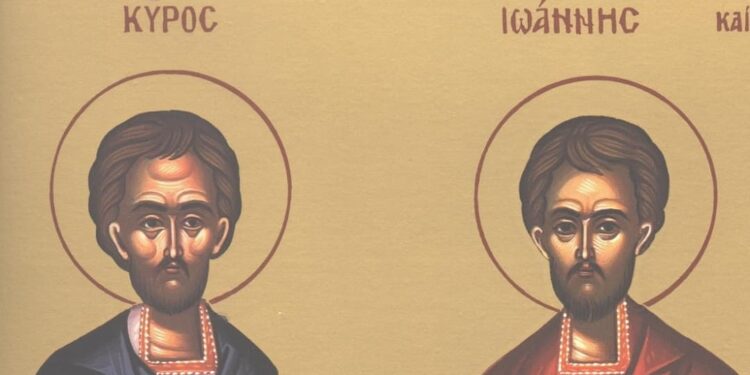On June 28 we commemorate the translation of the relics of the Unmercenary Wonderworkers Saints Cyrus and John from the city of Konopa, near Alexandria (where they suffered in the year 311) to the nearby village of Manuphin, in the year 412.
One century after their martyrdom, Saint Cyril, Patriarch of Alexandria (412 – 444), was praying to God to chase away the demons from the pagan temple of Manuphin, a city near Konopa.
An angel of the Lord told the holy patriarch the demons can only be cast away by bringing to Manuphin the relics of Saints Cyr and John. This is exactly what the patriarch did, building a church in honor of the two saints in Manuphin.
From that moment, the unclean spirits were chased away from the city and the two saints’ church became a wonder spring of God’s miracles.
St. Cyrus
St. Cyrus was born in Alexandria, Egypt, in the 3rd century. He studied and became a very good doctor. He was famous for treating his patients without pay or any other material rewards. He was healing them in the name of Christ, saying prayers and quoting from the Holy Scriptures. After he treated them, just like our Savior, he advised them to not sin anymore.
After Emperor Diocletian ordered great persecution against Christians in the Roman Empire, Cyrus went to Arabia, where he became a monk and was granted by God the gift of wonderworking.
St. John
St. John was a soldier in the city of Edessa, in Asia Minor. Hearing of the wonders made by St. Cyrus, he went to Arabia to meet him and became his disciple both in faith and the science of medicine, becoming himself also an unmercenary doctor saint.
When the saints found out that a woman named Athanasia was arrested together with her three daughters Teodota, Teoctista, and Eudoxia, for being Christians, they went to encourage her to remain steadfast in confessing her faith despite torture.
They were also arrested and tortured for this and, on January 31, they were beheaded together with Athanasia and her daughters.
Christian faithful took their bodies and buried them with honor in a place which is said to have been found only shortly before St. Cyril, Patriarch of Alexandria, was told to move them to Manuphin.
A more detailed account of their lives can be found under January 31 in the Orthodox Calendar.
Holy Martyr Papias
Holy Martyr Papias lived during the reigns of Roman emperors Diocletian and Maximian. He was told off for refusing to bring sacrifices to the Roman gods, and was arrested, and forced to sacrifice to the gods, which would have meant to abjure his Christian faith and worship the gods instead.
He disobeyed the governor’s order, for which he was terribly tortured. He was whipped, then thrown into a cauldron filled with boiling-hot of oil and grease. The patience with which he endured the torture brought many people to the Christian faith.
After much suffering, Saint Papias was beheaded.
Source: Basilica.ro

